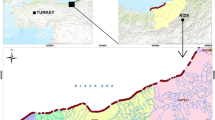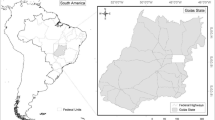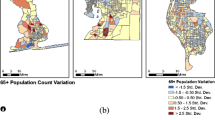Abstract
High numbers of road accidents at Jordan's major highways pose a substantial threat to public safety, necessitating strategic road safety interventions. This study presents hotspot spatial analysis based on severity indices for three prominent highways in Jordan via geographic information system (GIS) software. A comprehensive road accident network was constructed based on Jordanian road accident data (locations: Highways 30, 35, and 10) from year 2016 to 2019. Each incident's severity index was taken into consideration. Hotspot patterns were identified using GIS tools namely (a) Getis-Ord Gi* statistic and (b) Global Moran I index for spatial autocorrelation analysis, as they provide detailed information about the spatial distribution as well as statistical significance measures for road accident hotspots. The results revealed critical insights into the distribution of accident hotspots along the selected highways. In ascending order, the statistically significant hotspots observed were 14, 17, and 78 hotspots from Highways 10, 30, and 35. Hotspot patterns can be classified as random (Highway 30), dense (Highway 10), and dense clusters (Highway 35). Highway 35 demands targeted interventions to mitigate accidents along this route. This research takes away the hotspots along the highways that can be a good reference for stakeholders (e.g., transportation planners, policymakers, and relevant authorities) to implement best practices and road safety measures on Jordan's major highways.







Similar content being viewed by others
Data Availability
The data utilized to substantiate the results of this research can be obtained by contacting the corresponding author.
References
Abdulhafedh, A., & Abdulhafedh, A. (2017). “A Novel Hybrid Method for Measuring the Spatial Autocorrelation of Vehicular Crashes: Combining Moran’s Index and Getis-Ord Gi* Statistic.” Open Journal of Civil Engineering Scientific Research Publishing, 7(2), 208–221. https://doi.org/10.4236/OJCE.2017.72013
Abuaddous, M., et al. (2022). “Identification and Ranking of Accident Black Spots in Jordan.” Civil Engineering and Architecture Horizon Research Publishing, 10(4), 1661–1674. https://doi.org/10.13189/CEA.2022.100435
Afolayan, A., et al. (2022). GIS-Based spatial analysis of accident hotspots: A nigerian case study. Infrastructures Multidisciplinary Digital Publishing Institute, 7(8), 103. https://doi.org/10.3390/INFRASTRUCTURES7080103
Ahmed, S., et al. (2023). A study on road accident prediction and contributing factors using explainable machine learning models: Analysis and performance. Transportation Research Interdisciplinary Perspectives. Elsevier, 19, 100814. https://doi.org/10.1016/J.TRIP.2023.100814
Al-Aamri, A. K., et al. (2021). Mapping road traffic crash hotspots using GIS-based methods: A case study of Muscat Governorate in the Sultanate of Oman. Spatial Statistics. Elsevier, 42, 100458. https://doi.org/10.1016/J.SPASTA.2020.100458
Alam, M. S., & Tabassum, N. J. (2023). Spatial pattern identification and crash severity analysis of road traffic crash hot spots in Ohio. Heliyon. Elsevier, 9(5), e16303. https://doi.org/10.1016/J.HELIYON.2023.E16303
Aldala’in, S. A., et al. (2023). Road Accident Hotspots on Jordan’s Highway Based on Geometric Designs Using Structural Equation Modeling. Applied Sciences (Switzerland), 13(14), 8095. https://doi.org/10.3390/APP13148095
Alkaabi, K. (2023). Identification of hotspot areas for traffic accidents and analyzing drivers’ behaviors and road accidents. Transportation Research Interdisciplinary Perspectives. Elsevier, 22, 100929. https://doi.org/10.1016/J.TRIP.2023.100929
Alkhatni, F. et al. (2023) “Spatial Analysis of the Contribution of Parking Service Facilities to Traffic Crashes along Limited-access Roadways,” The Open Transportation Journal. Bentham Science Publishers Ltd., 17(1). https://doi.org/10.2174/18744478-V17-E230109-2022-35
Alomari, A. A. et al. (2019) “Evaluation of Traffic Accidents in Jordan Using Accident Hazard Scale .” Available at: https://www.researchgate.net/publication/329360649 (Accessed: April 23, 2022).
Al-Rousan, T. M., et al. (2021). Characteristics of crashes caused by distracted driving on rural and suburban roadways in Jordan. Infrastructures, 6(8), 107. https://doi.org/10.3390/INFRASTRUCTURES6080107
Atumo, E. A., Fang, T., & Jiang, X. (2022). “Spatial statistics and random forest approaches for traffic crash hot spot identification and prediction.” International Journal of Injury Control and Safety Promotion Taylor and Francis Ltd., 29(2), 207–216. https://doi.org/10.1080/17457300.2021.1983844
Azari, M., et al. (2023). “A GIS-based approach for accident hotspots mapping in mountain roads using seasonal and geometric indicators.” Applied Geomatics Springer Science and Business Media Deutschland GmbH, 15(1), 127–139. https://doi.org/10.1007/S12518-023-00490-2
Babaei, Z. and Kunt, M. M. (2023) “Tempo-categorization of road accident hotspots to enhance the problem diagnosis process and detect hidden hazardous locations,” Journal of Transportation Safety and Security. Taylor and Francis Ltd. https://doi.org/10.1080/19439962.2023.2169800
Baldík, V., et al. (2020). Position, extent and volume of slag accumulation in the cave system of the Rudice Sinkhole, a National Nature Monument, studied geophysical methods. Geoscience Research Reports. Czech Geological Survey, 53(1), 3–10. https://doi.org/10.3140/ZPRAVY.GEOL.2020.01
Bayiga Zziwa, E., Mutto, M. and Guwatudde, D. (2023) “Cluster analysis of the spatial distribution of pedestrian deaths and injuries by parishes in Kampala city, Uganda,” International Journal of Injury Control and Safety Promotion. Taylor and Francis Ltd. https://doi.org/10.1080/17457300.2023.2204490.
Behanova, A., Klemm, A., & Wählby, C. (2022). Spatial Statistics for Understanding Tissue Organization. Frontiers in Physiology. Frontiers Media SA, 13, 832417. https://doi.org/10.3389/FPHYS.2022.832417
Bindajam, A. A., et al. (2023). “Assessment of long-term mangrove distribution using optimised machine learning algorithms and landscape pattern analysis”, Environmental Science and Pollution Research. Springer Science and Business Media Deutschland GmbH, 30(29), 73753–73779. https://doi.org/10.1007/S11356-023-27395-2
Bisht, L. S., & Tiwari, G. (2023). Identification of road traffic crashes hotspots on an intercity expressway in India using geospatial techniques. IATSS Research. Elsevier B.V., 47(3), 349–356. https://doi.org/10.1016/J.IATSSR.2023.07.003
Cao, Y., Li, S., & Fu, C. (2020). An Assessment Method of Urban Traffic Crash Severity Considering Traveling Delay and Non-Essential Fuel Consumption of Third Parties. Sustainability, 12(17), 6806. https://doi.org/10.3390/SU12176806
Colak, H. E., et al. (2018). Hot spot analysis based on network spatial weights to determine spatial statistics of traffic accidents in Rize, Turkey. Arabian Journal of Geosciences. Springer Verlag, 11(7), 1–11. https://doi.org/10.1007/s12517-018-3492-8
dos Santos, A. M., et al. (2022). “Spatio-temporal analysis of accident hotspots on federal highways in the state of Goiás, Brazil”, GeoJournal. Springer Science and Business Media Deutschland GmbH, 87(5), 3839–3854. https://doi.org/10.1007/S10708-021-10472-9/METRICS
Erdogan, S., et al. (2015). “A model suggestion for the determination of the traffic accident hotspots on the turkish highway road network: a pilot study”, boletim de ciencias geodesicas. Universidade Federal Do Parana, 21(1), 169–188. https://doi.org/10.1590/S1982-21702015000100011
Hazaymeh, K., Almagbile, A., & Alomari, A. H. (2022). Spatiotemporal analysis of traffic accidents hotspots based on geospatial techniques. ISPRS International Journal of Geo-Information, 11(4), 260. https://doi.org/10.3390/IJGI11040260
Heydari, S., et al. (2019). Road safety in low-income countries: State of knowledge and future directions. Sustainability, 11(22), 6249. https://doi.org/10.3390/SU11226249
Hisam, F. N. S. A., et al. (2022). “GIS Analysis on Road Accident and Road Safety: A Case Study of Road Geometry in Kajang, Selango0.” International Journal of Geoinformatics Association for Geoinformation Technology, 18(4), 45–50. https://doi.org/10.52939/IJG.V18I4.2257
Hovenden, E., & Liu, G.-J. (2020). “Use of spatial analysis techniques to identify statistically significant crash hot spots in Metropolitan Melbourne.” Journal of Road Safety Australasian College of Road Safety, 31(4), 36–58. https://doi.org/10.33492/JRS-D-19-00249
Jima, D., & Sipos, T. (2023). Examining traffic crash scene using density estimation and its relevance to determine intersection zone road network blackspot location. Egyptian Journal of Remote Sensing and Space Science, 26(3), 595–606. https://doi.org/10.1016/J.EJRS.2023.07.002
Jordan Traffic Department (2022) “Annual report of road accidents,” Jordan Traffic Department.
Khan, I. U., et al. (2023). Hotspot analysis of single-vehicle lane departure crashes in North Dakota. IATSS Research. Elsevier, 47(1), 25–34. https://doi.org/10.1016/J.IATSSR.2022.12.003
Khatun, M. S., et al. (2024). Identification and analysis of accident black spots using Geographic Information System (GIS): A study on Kushtia-Jhenaidah national highway (N704), Bangladesh. Heliyon. Elsevier Ltd, 10(3), e25952. https://doi.org/10.1016/j.heliyon.2024.e25952
Le, K. G., Liu, P., & Lin, L. T. (2020). Traffic accident hotspot identification by integrating kernel density estimation and spatial autocorrelation analysis: a case study. Taylor & Francis, 27(2), 543–553. https://doi.org/10.1080/13588265.2020.1826800
Maaiah, B., Al-Badarneh, M., & Al-Shorman, A. (2021). Mapping potential nature based tourism in Jordan using AHP, GIS and remote sensing. Journal of Ecotourism, 22(2), 260–280. https://doi.org/10.1080/14724049.2021.1968879
Masron, T., et al. (2019). “Applying GIS in analysing black spot areas in Penang, Malaysia.” Indonesian Journal of Geography Gadjah Mada University, 50(2), 113–114. https://doi.org/10.22146/IJG.27440
Mekonnen, A. A., Sipos, T., & Krizsik, N. (2023). Identifying hazardous crash locations using empirical bayes and spatial autocorrelation. ISPRS International Journal of Geo-Information, 12(3), 85. https://doi.org/10.3390/IJGI12030085
Mesquitela, J., et al. (2022). Data analytics process over road accidents data—a case study of Lisbon City. ISPRS International Journal of Geo-Information, 11(2), 143. https://doi.org/10.3390/IJGI11020143
Mhetre, K. V., & Thube, A. D. (2023). “Road safety, crash hot-spot, and crash cold-spot identification on a rural national highway in maharashtra, India.” Materials Today: Proceedings Elsevier Ltd, 77, 780–787. https://doi.org/10.1016/J.MATPR.2022.11.447
Mohammed Fayaz, M. et al. (2018) “Black spot identification using accident severity index method,” International journal of Current Engineering and Scientific Research (IJCESR) , 5(3), p. 63. Available at: http://troindia.in/journal/ijcesr/vol5iss3part6/63-68.pdf (Accessed: April 27, 2022).
Mohammed, S. et al. (2023) “GIS-based spatiotemporal analysis for road traffic crashes; in support of sustainable transportation Planning,” Transportation Research Interdisciplinary Perspectives. Elsevier Ltd, 20. https://doi.org/10.1016/J.TRIP.2023.100836.
Munasinghe, D. (2023). “Spatial Analysis of Urban Road Traffic Accidents Using GIS.” British Journal of Multidisciplinary and Advanced Studies European Centre for Research Training and Development, 4(6), 70–83. https://doi.org/10.37745/BJMAS.2022.0368
Prasad, R. R., Suresh, G. L., & Rao, M. Y. (2023). “Identification, analysis and improvement of accident blackspots: A case study of Narasaraopet mandal, Andhra Pradesh.” International Conference on Smart Materials and Structures, ICSMS-2022 AIP Publishing, 2810(1), 080001. https://doi.org/10.1063/5.0146863/2899718
Pusuluri, V. L., Dangeti, M. R., & Kotamrazu, M. (2023a). “Road crash zone identification and remedial measures using GIS”, Innovative Infrastructure Solutions. Springer Science and Business Media Deutschland GmbH, 8(5), 1–20. https://doi.org/10.1007/S41062-023-01111-Y/FIGURES/1
Pusuluri, V. L., Dangeti, M. R. and Kotamrazu, M. (2023b) “Road crash zone identification and remedial measures using GIS,” Innovative Infrastructure Solutions. Springer Science and Business Media Deutschland GmbH, 8(5). https://doi.org/10.1007/S41062-023-01111-Y.
Qalb, A., et al. (2023). “Risk reduction via spatial and temporal visualization of road accidents: A way forward for emergency response optimization in developing countries.” International Journal of Injury Control and Safety Promotion Taylor and Francis Ltd., 30(2), 310–320. https://doi.org/10.1080/17457300.2022.2164312
Rahman, M. T., Jamal, A., & Al-Ahmadi, H. M. (2020). Examining hotspots of traffic collisions and their spatial relationships with land use: A GIS-based geographically weighted regression approach for Dammam, Saudi Arabia. ISPRS International Journal of Geo-Information, 9(9), 1–22. https://doi.org/10.3390/ijgi9090540
Sae-ngow, P., & Kulpanich, N. (2023). Spatial Statistics and Severity of Highway Accidents in Nakhon Pathom, Thailand. International Journal of Geoinformatics. Geoinformatics International, 19(4), 13–23. https://doi.org/10.52939/ijg.v19i4.2629
Sajed, Y., Shafabakhsh, G., & Bagheri, M. (2019). “Hotspot location identification using accident data, traffic and geometric characteristics.” Engineering Journal Chulalongkorn University, Faculty of Fine and Applied Arts, 23(6), 191–207. https://doi.org/10.4186/ej.2019.23.6.191
Samani, R. R., & Amador-Jimenez, L. (2023). “Exploring road safety of pedestrians in proximity to public transit access points (bus stops and metro stations), a case study of Montreal, Canada”, Canadian Journal of Civil Engineering. Canadian Science Publishing, 50(6), 536–547. https://doi.org/10.1139/CJCE-2022-0281
Sarker, I. H. (2021). Machine Learning: Algorithms, Real-World Applications and Research Directions. SN Computer Science. Springer, 2(3), 1–21. https://doi.org/10.1007/S42979-021-00592-X/FIGURES/11
Srikanth, L. and Srikanth, I. (2020) “A Case Study on Kernel Density Estimation and Hotspot Analysis Methods in Traffic Safety Management,” in 2020 International Conference on COMmunication Systems and NETworkS, COMSNETS 2020. Institute of Electrical and Electronics Engineers Inc., 99–104. https://doi.org/10.1109/COMSNETS48256.2020.9027448
Tamakloe, R. (2023). Risk Factors Influencing Fatal Powered Two-Wheeler At-Fault and Not-at-Fault Crashes: An Application of Spatio-Temporal Hotspot and Association Rule Mining Techniques. Informatics, 10(2), 43. https://doi.org/10.3390/INFORMATICS10020043
Tang, J. H., Tseng, T. J., & Chan, T. C. (2019). Detecting spatio-temporal hotspots of scarlet fever in Taiwan with spatio-temporal Gi* statistic. PLOS ONE. Public Library of Science, 14(4), e0215434. https://doi.org/10.1371/JOURNAL.PONE.0215434
Wang, T., et al. (2023). Temporal and spatial trends in road traffic fatalities from 2001 to 2019 in Shandong Province, China. PloS One. NLM (medline), 18(7), e0287988. https://doi.org/10.1371/JOURNAL.PONE.0287988
Wee, C. P. J., et al. (2021). Geospatial analysis of severe road traffic accidents in Singapore. Singapore Medical Journal, 62(7), 353. https://doi.org/10.11622/SMEDJ.2020037
Wilches-Mogollon, M. A., et al. (2024). “Impact assessment of an active transport intervention via systems analytics”, Transportation Research Part D: Transport and Environment. Pergamon, 128, 104112. https://doi.org/10.1016/J.TRD.2024.104112
Zahran, E. S. M. M., et al. (2019). Spatial analysis of road traffic accident hotspots: Evaluation and validation of recent approaches using road safety audit. Taylor & Francis, 13(6), 575–604. https://doi.org/10.1080/19439962.2019.1658673
Zhang, K., & Wang, Z. (2023). “LTPP data-based investigation on asphalt pavement performance using geospatial hot spot analysis and decision tree models”, International Journal of Transportation Science and Technology. KeAi Communications Co., 12(2), 606–627. https://doi.org/10.1016/J.IJTST.2022.06.007
Acknowledgements
The authors would like to thank Al-Hussein Bin Talal University for facilitating the procedures to conduct this research. We extend our gratitude to Ayed Taran, and Hind Sarayreh for their previous contributions to the manuscript.
Funding
This study did not receive any financial support from external sources.
Author information
Authors and Affiliations
Contributions
Conceptualization, Safa Sababhi; Methodology, Shatha Aldala’in; Data curation, Safa Sababhi; Writing—Original draft preparation, Safa Sababhi and Shatha Aldala’in; Visualization, Aymen Al Taani; Investigation, Shatha Alrawashdeh; Software, Safa Sababhi, and Shatha Aldala’in; Validation, Zubeida Aladwan; Writing—Reviewing and Editing, Teh Sabariah Binti Abd Manan, and Thahab Al Barari. All authors have read and agreed to the published version of the manuscript.
Corresponding author
Ethics declarations
Ethical approval
The study is based on secondary sources of data. We have followed all ethnical terms and conditions to prepare the manuscript. The sources are declared with references. Therefore, this study did not require ethics review.
Conflicts of interest
The authors declare no conflict of interest.
Additional information
Publisher's Note
Springer Nature remains neutral with regard to jurisdictional claims in published maps and institutional affiliations.
Rights and permissions
Springer Nature or its licensor (e.g. a society or other partner) holds exclusive rights to this article under a publishing agreement with the author(s) or other rightsholder(s); author self-archiving of the accepted manuscript version of this article is solely governed by the terms of such publishing agreement and applicable law.
About this article
Cite this article
Sababhi, S., Aldala’in, S., Al Taani, A. et al. Safety on Jordan's highways: A GIS-Based approach to identifying road accident hotspots. GeoJournal 89, 105 (2024). https://doi.org/10.1007/s10708-024-11115-5
Accepted:
Published:
DOI: https://doi.org/10.1007/s10708-024-11115-5




